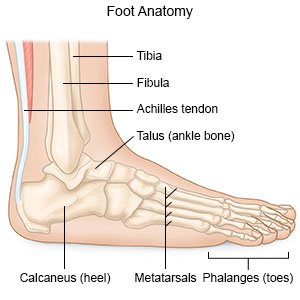Foot Osteotomy
Medically reviewed by Drugs.com. Last updated on Aug 4, 2025.
AMBULATORY CARE:
A foot osteotomy
is surgery to remove parts of a bone in your foot. The bone is reshaped to relieve pressure from deformity or injury. Some examples include a fracture, bunion, hammer toe, or flat foot.
 |
How to prepare for your surgery:
You will have several x-rays of your foot before the surgery. The x-rays will help your healthcare providers plan your surgery. Your healthcare provider may tell you not to eat after midnight the day before your surgery. He or she will tell what medicines to take or not to take the morning of your surgery. Arrange to have someone drive you home and stay with you after surgery.
What will happen during your surgery:
You will be given anesthesia medicine. The type of anesthesia will depend on what other surgery is being done with the osteotomy. You may be given general anesthesia to keep you asleep and free from pain during surgery. You may instead be given anesthesia in your spine, leg, or foot to numb the surgery area. With this type of anesthesia, you may still feel pressure or pushing during surgery, but you should not feel any pain.
- Your surgeon will make an incision over the area to be fixed. The bone will be cut. A wedge shaped piece of bone may be removed. Your bone will be moved into it's proper place. Pins, screws, or plates may be put in to hold your bone in place.
- The incision will be closed with stitches and a bandage will be placed over your foot. You may not be able to put weight on your foot for as long as directed. You may instead be given a special boot or shoe to wear that protects your foot while it heals. You may need to have a cast placed a few weeks after surgery once the swelling decreases.
What will happen after your surgery:
You may be able to go home after surgery. You may need to use crutches or a knee walker to keep weight off your foot. Have someone to help you for the first few days after surgery.
Risks of a foot osteotomy:
You may bleed more than expected or develop an infection. The nerves or blood vessels in your foot may be damaged. Your bone may not heal as expected. You may need another surgery. You may still have pain and stiffness.
Seek care immediately if:
- Your foot, ankle, or leg feels warm, tender, and painful. It may look swollen and red.
- Blood soaks through your bandage.
- Your dressing becomes too loose or gets wet.
Contact your healthcare provider if:
- You have a fever or chills.
- You develop a rash.
- Your pain does not get better after taking pain medicine.
- You have questions or concerns about your condition or care.
Medicines:
You may need any of the following:
- Prescription pain medicine may be given. Ask your healthcare provider how to take this medicine safely. Some prescription pain medicines contain acetaminophen. Do not take other medicines that contain acetaminophen without talking to your healthcare provider. Too much acetaminophen may cause liver damage. Prescription pain medicine may cause constipation. Ask your healthcare provider how to prevent or treat constipation.
- Antibiotics help treat or prevent an infection caused by bacteria.
- Take your medicine as directed. Contact your healthcare provider if you think your medicine is not helping or if you have side effects. Tell your provider if you are allergic to any medicine. Keep a list of the medicines, vitamins, and herbs you take. Include the amounts, and when and why you take them. Bring the list or the pill bottles to follow-up visits. Carry your medicine list with you in case of an emergency.
Incision bandage care:
Keep the bandage clean, dry, and in place until your follow up visit with your healthcare provider. Cover your foot with a plastic bag when you shower or bathe.
Decrease swelling:
- Elevate your foot above the level of your heart as often as you can. Prop your foot on pillows or blankets to keep it elevated comfortably.
- Apply ice on your foot for 15 to 20 minutes every hour or as directed. Use an ice pack, or put crushed ice in a plastic bag. Cover it with a towel.
Activity:
- Do not drive until your healthcare provider says it is okay.
- Use assistive devices. You may need to use crutches or a knee walker to keep from putting weight on your foot. Follow your healthcare provider's instructions on putting weight on your foot. Your bones may not heal properly if you do not follow instructions.
- Go to physical therapy as directed. A physical therapist will teach you exercises to increase your range of motion and strength in your foot.
Follow up with your surgeon as directed:
You will need to return to have your stitches removed. You may also need x-rays to check if your bones are healing properly. Write down your questions so you remember to ask them at your visits.
© Copyright Merative 2025 Information is for End User's use only and may not be sold, redistributed or otherwise used for commercial purposes.
The above information is an educational aid only. It is not intended as medical advice for individual conditions or treatments. Talk to your doctor, nurse or pharmacist before following any medical regimen to see if it is safe and effective for you.
Further information
Always consult your healthcare provider to ensure the information displayed on this page applies to your personal circumstances.
